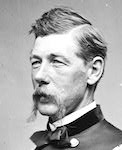 Open main menu
Open main menu
 Open main menu
Open main menu

A. Shaler
(1827 - 1911)
Home State: New York
Command Billet: Commanding Regiment
Branch of Service: Infantry
Unit: 65th New York Infantry
Before Antietam
Originally a stone mason in his father's business, he had long service in the New York State Militia, first enlisting in 1845. By 1860 he was Major of the 7th New York Militia and published the Manual of Arms for Light Infantry that year. He and his unit, then in Federal service, were in the defenses of Washington, DC in May and June 1861.
Then, at age 34, he enrolled in New York City and mustered as Lieutenant Colonel of the 65th New York Infantry on 11 June 1861. He was promoted to Colonel on 17 July 1862 after Colonel Cochran was appointed Brigadier General.
On the Campaign
He commanded the regiment in Maryland. They were in Pleasant Valley on 16 September, marched nearly to Harpers Ferry and back to Keedysville on the 17th, and arrived on the battlefield of Antietam about 11 a.m. on 18 September 1862.
The rest of the War
He was appointed Brigadier General of Volunteers on 23 January 1863. He was later awarded the Medal of Honor for his actions at Marye's Heights, Fredericksburg, VA on 3 May 1863. He led the Brigade on the Gettysburg Campaign and commanded the prisoner of war camp at Johnson's Island, OH over the winter of 1863-64. He returned to the field but was captured in action at the Wilderness, VA on 6 May 1864 and was a prisoner at Richmond, VA and Macon, GA before being exchanged by November 1864. He served briefly in the Western Theater and mustered out in August 1865. He was honored by brevet to Major General of Volunteers in January 1866.
After the War
He was appointed Major General in the NY State Militia in 1867 and was a New York City Fire Commissioner from 1867-1873 (living in Hackensack, NJ). After the major fire in Chicago in 1874, he helped reorganize the fire department there. He was also an early supporter of the National Rifle Association (NRA), founded in 1871, and served as its President in 1876. By 1880 he was back living in New York City, was president of a mining company, and was involved with other businesses, including the Automatic Signal Telegraph Company. From 1883-87 he was president of the NYC Health Department. He resigned his Major General's commission in 1885 under some pressure from charges of corruption. In 1900 he was living in Bergen County, NJ - serving as Mayor of Ridgefield, NJ (1899-1901) - but was back in the City and retired by 1910.
References & notes
His service from the Adjutant General.1 Personal details from family genealogists, the US Census for 1870-1910, a bio sketch in Hammersly's Officers of the Volunteer Army and Navy who served in the Civil War (1893) and his obituary in the New York Times of 28 December 1911. His gravesite is on Findagrave. His picture from a photograph at the Library of Congress. There's a fine standing portrait of him, probably also by the Brady Studio, in the collection of the National Portrait Gallery.
More on the Web
See a December 1874 Harper's Weekly illustration of Shaler and members of the Chicago Fire Department, online thanks to Terry Gregory on Chicagology.
Birth
03/19/1827; Haddam, CT
Death
12/28/1911; New York City, NY; burial in English Neighborhood Reformed Ch, Ridgefield, NJ
1 State of New York, Adjutant-General, Annual Report of the Adjutant General of the State of New York [year]: Registers of the [units], 43 Volumes, Albany: James B. Lyon, State Printer, 1893-1905, For the Year 1901, Ser. No. 27, pg. 692 [AotW citation 26173]